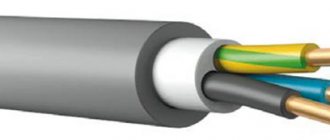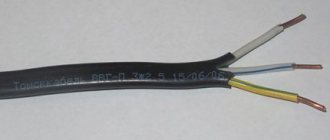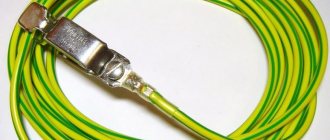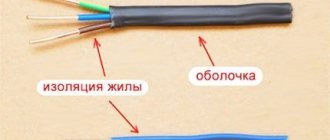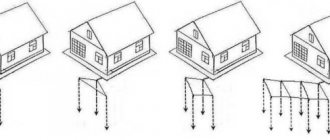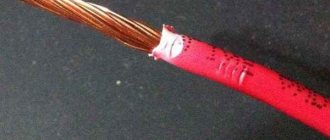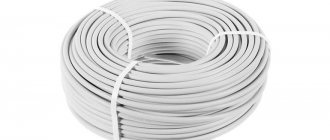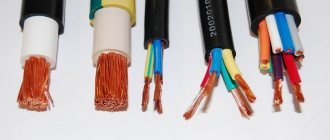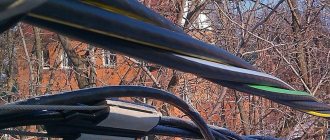An electrical cable is the main element of the electrical network, which is always laid during the construction of a house. After all, without it, not a single electrical appliance in the building will work. In order to carry out installation work correctly, you need to know which wire to use for wiring in the house. For this reason, we will first talk about the design features of a modern electrical cable, and also consider its popular types, and how to choose the cross-section of the wire for your home.
Layed wire under the ceiling of a house Source sense-life.com
Design features of the electrical wire
The design of any electrical wire contains cores. These are the main elements of the cable. Each of them has a shell. It is internal insulation. Current is transmitted directly through the veins. Any number of them is contained in a common outer protective shell. The number of cores is always taken into account when deciding which cable to choose for wiring in the house.
In addition to current-carrying elements, their insulating protection, and the outer sheath, the design of an electrical cable may also contain additional components. For example, this is the internal common shell. It is located in the wire between the outer protective layer and the insulated conductors. The electrical cable may also have armor made of wire or steel.
Structure of an electrical cable Source elektrikii.ru
Manufacturers produce electrical wires with cores that can be solid single-wire. Cables consisting of multi-wire conductive elements are also produced. Such veins are made from a large number of thin threads.
Important! Do not confuse a single-core electrical wire with a single-wire conductive element. After all, a single core in an electrical cable can consist solely of one or several wires twisted together.
Professionals choose electrical wiring for their home based on their experience. They take into account the level of ease of working with it. Experts also take into account what material the electrical cable cores are made of. After all, manufacturers make conductive elements of electrical wires from aluminum or copper.
When comparing these metals, it is noted that aluminum conductors make it possible to produce cheaper cables. However, such wires are characterized by lower electrical conductivity. Therefore, with the same cross-sections, copper wires will pass more electric current.
Wires with aluminum conductors have low electrical conductivity Source lomrf.ru
Copper wiring also has one disadvantage. It lies in the impossibility of a high-quality direct connection of copper with another metal. In other words, special adapters are used to connect copper and aluminum wiring. They are used to prevent the formation of a galvanic couple at the junction.
On a note! Experts believe that aluminum cables are not the best option for home electrical wiring. This is due precisely to their low electrical conductivity. In addition, electrical cables made of aluminum can quickly oxidize and break at bending points.
If wires made of different materials are twisted together, then oxidation of the junction will occur. Therefore, the contact between the electrical cables will disappear, which will lead to a short circuit in the electrical network.
Important! It is necessary to use the same type of wiring cable throughout the house.
Manufacturers produce wires with general protective insulation, for the manufacture of which the following is used:
- polyethylene;
- rubber material;
- polyvinyl chloride
Electric cable with polyvinyl chloride protection Source pskabel.ru
Any cable for wiring in the house is produced with an outer sheath, which has high insulating properties. The outer braid provides reliable protection against water. Modern wires are used to create electrical networks of various classes with a maximum voltage of 500 V.
See also: Catalog of companies that specialize in electrical work of any complexity
How to check the cable when purchasing
They check whether the products are made according to the requirements of GOST or TU . In the latter case, you need a certificate of conformity issued by an organization with such operating rights, for example, VNII KP. Pay attention to the quality of the metal , for example, the properties of copper depend on the class, of which three are used in the production of wires.
Unscrupulous manufacturers underestimate the cross-section of the cores . GOST states that this value can be reduced if the total resistance remains unchanged. But thin wires heat up faster, which leads to emergency situations.
A thin shell will not lead to breakdown of the lighting wire, but it will be more easily damaged, especially for flexible wires for portable lamps. Protective insulation must contain information from the manufacturer about its composition.
Popular electrical cables for the home
When a specialist decides which cable to use for wiring in a house, he, first of all, focuses on existing types of wires. An important selection criterion is the number of cores required. Many manufacturers produce cables with 1-5 conductive elements. Such products have different purposes. Therefore, it is necessary to consider the main common types of wires for electrical wiring in private residential buildings.
Type 1 – VVG cable
When laying in-house electrical wiring, including installation of an electrical network using distribution boxes, VVG cable is often used. It is through it that current is transmitted. It can withstand a maximum voltage of 1000 V. Manufacturers produce this current conductor with cores, the number of which does not exceed 5 pieces.
Four-core electrical cable VVG Source files.glotr.uz
For VVG products the cross-section can be:
- flat;
- round;
- square;
- triangular.
The advantages of VVG electrical cables include the wide temperature range at which these products are used. For such current conductors it ranges from -50 to +50 ℃. Electrical wires of this type can withstand high breaking loads. They are also renowned for their ability to be used in environments that are 98% critical.
Electric cable VVG can be designated as follows:
- NG – insulating shell that does not support the combustion process;
- Z – the presence of rubber material or polyvinyl chloride bundles between the external protection and the insulated conductors;
- P – flat wire.
On a note! VVG cable for electrical wiring, with the exception of the wire with the letter “Z”, is manufactured without filling the space that is located between the insulated conductors and the external protection.
Three-core electrical cable VVG with empty space between the outer sheath and the insulating material of each current-carrying core Source kemerovo.tdsevcable.ru
When creating home electrical lines, a wire marked VVGng-LS is often used. Such products meet all safety criteria and are sold at an affordable price. Its insulation contains a minimum of halogens. Therefore, the wire burns and smolders more slowly. This makes it possible to inhale less dangerous doses of toxic substances during a fire. In addition, people will be able to evacuate longer.
Accepted markings of cores inside cables for lighting
Traditionally, cable insulation has different colors. This makes it easier to carry out electrical installation work on lighting houses and apartments. Thus, a red, brown or white sheath is present on live wires (denoted in the diagrams by the letter “L”). The blue wire means “zero” (letter “N” in the diagram), and green or yellow-green colors are used for the ground wire (letter “PE”).
Important : when carrying out electrical installation work in buildings with old wiring, you must ensure that the color of the insulation matches the purpose of the wire. For this, an indicator or other special devices are used.
For a two-core cable we have only phase and zero.
Selection of wire cross-section
Manufacturers produce electrical cables exclusively with a standardized cross-sectional area. When choosing this parameter for any wire, the current strength in the electrical network is taken into account. It is also necessary to take into account the material of manufacture of the current-carrying conductors and the place where the wiring is installed. Experts never forget about the last point, because the electrical cable can get very hot.
On a note! There are cases when it is necessary to lay several very hot wires in one tray. In such a situation, mutual heating of conductive products reduces the permissible current strength to 30%.
In order to accurately determine what cross-section of wire to use for wiring in the house, you must first know the sum of the current values of all electrical appliances in the building. Therefore, it is important, even at the design stage of electrical wiring, to determine as accurately as possible the quantity and type of equipment used in the construction.
It is important to know as accurately as possible the number and parameters of the equipment used in the house in order to correctly calculate the cross-section of the electrical wiring Source imageban.ru
To calculate the required cross-section in mm², the power of all devices is usually first divided by the network voltage, which is 220 V. After this, it is taken into account that 1 mm² of copper electrical cable passes 10 A through itself, and 4-6 A from aluminum.
So, if an electrical appliance has a power of 4 kW, then the current will be 18.18 A. To calculate this value, you only need to divide 4000 W by 220 V. To connect an electrical appliance with this power, you will need to use an electrical cable with copper conductors, whose cross-section is 1.8 mm².
It is recommended to increase the calculated value by 1.5 times. This action is performed for safety reasons. Taking into account the margin for the example under consideration, it is necessary to use an electrical wire with copper conductors whose cross-section is 2 mm². If you choose an aluminum cable, then you will have to purchase a wire whose conductive cores will be 2.5 times thicker.
Subtleties of connecting electrical equipment
Apartment owners often need to connect large household appliances, such as an electric stove or washing machine, to a power outlet.
Flexible wires are intended for these purposes, and you should take into account clause 2.1.48 of the PUE 7 , according to which you can only take products whose purpose is indicated in the standards and technical specifications.
For example, to connect a hob, you should select a wire whose certificate contains a mention of such use of this product.
Briefly about the main thing
Electrical cables are made with cores that are usually made of copper. However, there are also electrical products with conductive elements made of aluminum. The design of any electrical wire also includes an outer sheath and insulation of each core. Perhaps there is also an internal common shell and armor in the form of a metallized layer.
In homes, VVG and NYM wires are most often used. Less commonly used is PUNP electrical cable, which is of lower quality. Experts recommend using VBBShV electrical products in the ground. This is an armored wire.
The cable cross-section is determined by the current strength. To calculate it, divide the power of electrical appliances by the network voltage. In this case, it is additionally taken into account that 1 mm² of copper wire can pass 10 A.
terms of Use
In an apartment and private house
When choosing a cable for electrical wiring, most often the same brand is used for sockets, lighting and individual powerful consumers. Therefore, you can use the same option for the light as for the socket group. The most popular cable for lighting in apartments and houses is VVG. When installing hidden wiring, it is one of the best options. In a wooden house, you should use a cable that does not propagate combustion - VVGng, VVGng-LS or NYM.
On the street or in the garage
First you need to decide how the wiring will be laid. The fact is that with open wiring, the cable is laid in pipes or in corrugation. In the case of underground installation, you can use armored cables or ordinary ones, but laid in a PVC pipe. For lighting in a garage, the recommendations are similar - laying external wiring in a protective corrugation will protect the wire from mechanical damage and rodents.
I wonder how many wires are needed for lighting? You can use 2 or 3 wire wire. Using a 3-core wire will make it possible to install two groups of lamps by connecting another phase to the third core. Also, a three-wire wire is mandatory to use if there is grounding. If you do not have a ground connection, it is still better to use a three-core conductor when installing the wiring so that there is no need to change the cable in the future.
On the balcony or porch of the house
In the case of installing a street lamp on the porch, the lighting wire can be laid both internally and externally. And in the case of installation in the wall, the VVG 2x0.75 cable is perfect. For external laying, you can use the same, but be sure to lay it in a protective corrugation or pipe. Also suitable in this case is a round wire of the PVA brand or a flat SHVVP - they are flexible and will be easier to insert into the corrugation.
Important! When using a wire with a stranded core, the ends that will be connected to the lamp, if you use a screw terminal block, must be tinned or terminated with NShVI type lugs. If you use WAGO terminals, this is not necessary.
In the garden
The wire for connecting lighting in the garden must be laid overhead or underground. Air laying in this case is not always possible, because it requires posts; it is also possible to lay wires along the fence. In this case, the recommendations are as follows:
- If several groups of powerful lamps are intended to illuminate the entire area, then VVG 3x1.5 or flexible wire grades listed above will be suitable.
- The cable must be protected with corrugation.
For laying cables in a trench, a variant of the VBBShV brand is suitable - this is an armored copper cable. It is suitable for digging into the ground without additional protection, if there is no heavy load on the soil. That is, if you are laying a cable in the ground under a parking area for cars, it is better to protect it in this area by laying it in a HDPE pipe or PVC sewer pipe. In underground pipes, you can use both the VVG brand and other “unprotected” brands of wires.
Applications in lighting systems
To organize lighting, you can use both wires and cables, depending on the conditions:
- It is convenient to use cables for indoor wiring - three conductors (phase, neutral, ground) are laid simultaneously;
- Wires can be used for installation in distribution panels or wiring where it is difficult to lay cables;
- outdoors, for the most part, cables are used - due to increased mechanical strength, protection of current-carrying conductors, and also because of the aforementioned convenience;
- When laying overhead (overhead lines, etc.), it is convenient to use SIP - no additional cable is required.
In difficult cases, you need to look at the situation, but it is always better to focus on the cable - for reasons of reliability.
Types of home wiring
There are two types of home wiring: open and hidden. For residential premises, hidden installation is most often used. Open wiring can be used in the country, in private and country houses, various outbuildings and utility rooms.
Open wiring
This type of gasket attracts with its simplicity. You can easily change the direction of the cable, repair it or perform other work. However, such a line will not look aesthetically pleasing and will most often be less safe.
Hidden wiring
It looks neat, it is not visible, it has a longer service life, the cable is protected from mechanical influences and natural factors. More difficult to install, repair and maintain. Also, a hidden electrical wire may be accidentally damaged when performing other work involving drilling or drilling holes.
Calculation examples
For example, you need to install a cable for a stove in the kitchen. The stove says it consumes 8 kilowatts. The house has grounding and a 220 volt stove.
Here, first you need to find out the cross-section of the cable (its thickness, or rather its cross-sectional area), for this we divide the power consumption (8 kilowatts) by two:
8 / 2 = 4
Now we know the cable cross-section - 4 square millimeters.
What should you say in the store? You need a VVG-NG-LS 3x4 cable (here the three is the number of cores, and the four is the cable cross-section that we just calculated).
Simply measure the length with a tape measure along the walls and ceiling, where the wire will go, and add at least 1 meter so that there is room for installation and maneuvers.
Alternative solutions
In addition to those discussed above, it is worth highlighting a number of other brands of cables used in organizing street wiring:
- PVC is a flexible cable with a PVC sheath and marked wires. The number of cores is from two to five.
- VVG is a power cable with a number of cores from one to five. It is distinguished by its flat shape and double insulation, which allows the wire to be used outdoors.
- PV, APV, PV1 and other wires are suitable for laying external wiring, but only if they are located in pipes. The main disadvantage is the presence of single insulation, which makes them vulnerable to mechanical stress.
- VBBvng is a product characterized by fire resistance and flexibility. The number of cores is from one to six. Most often used to connect portable devices.
After the 2000 Bell Telecom building tragedy in New York City, cable manufacturers changed safety standards. The reason is the release of toxic gases from the braided wires during the combustion process, which is why most people died. In addition, toxic gases also negatively affect complex electronics. That is why at the present stage manufacturers focus on the production of non-flammable wires characterized by low levels of gas and smoke emissions.
